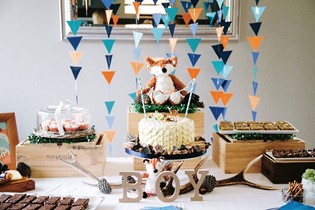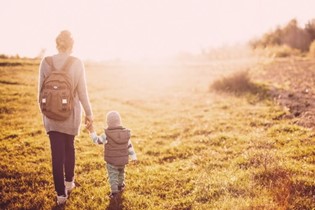Paws for thought: does your little one need a pet?

Sarah Tennant weighs in on the ‘shall we get a pet’ debate.
Some consider pets a childhood rite of passage, but there are several schools of thought when it comes to combining animals and children.
The first approach is the ‘baby’s best friend’ idea. This is inspired by photoshoots of newborns curled up adorably on the Saint Bernard, and YouTube compilations of babies giggling as dogs lick their faces.
Then there’s the ‘pet as parenting tool’ approach. Devoid of sentiment, this involves buying a sacrificial guinea pig to teach tots lessons about responsibility, turn-taking, menial labour and, when 'Patch' gets done in by the neighbour’s cat, the Circle of Life.
There’s the 'I don’t like pets, but my children won’t stop nagging for one' approach. This one involves a lot of bargaining down – less fur, less size, less maintenance, less expense, less parental involvement. Children of these parents often have to settle for goldfish, which pleases no one because goldfish are boring and surprisingly high-maintenance. (True, tragic story: we got Arthur and Guinevere and installed their fishbowl in the dining room. Two days later, we bought Guinevere II. We ran through Guineveres III through VIII and a second Arthur before we gave up. Turned out, we’d put their bowl directly opposite the EcoMist automatic fly spray. We poisoned an entire dynasty.)
There’s also the ‘pet lover who happened to get pregnant’ approach. These parents spend their entire first pregnancy worrying that Fluffy will feel neglected when the baby comes along. This pet-centric mentality generally vanishes after bringing the baby home, especially if Fluffy wakes it up.
Lastly, there’s the ‘are you freaking kidding me’ attitude. The ‘I have three kids under five, my house is already a zoo, and you want me to add to the menagerie?!’ attitude. The ‘we can barely afford chops and I’m supposed to buy scientifically-formulated kibble?’ attitude. The ‘you think I want to clean up MORE poop?’ attitude. Well, fair enough.
Personally, my husband and I have adopted a utilitarian, wannabe-lifestyle-block approach. We don’t have pets, but the kids are allowed to love the livestock. Currently our suburban backyard features a chicken, four meat rabbits and three children who get a great kick out of saying ‘meat rabbits’ to their friends.
Two sides to the story
I have some sympathy with most of these views, though. Pets are a complicated issue. For every heartwarming memory of man’s best friend, there’s a horror story of the toddler whose dog had never shown any signs of aggression, ever, until one day… Some folk have a cat wander in off the street and slot neatly into their lives; others buy an expensive, pedigreed beastie and spend the next four years forking over thousands in vet bills as it slowly falls to pieces. My husband knows a dog who jumped a ten-foot fence to save his owner’s life; but then, he also once owned a dog who spent her days shuffling up and down the kitchen floor, diligently licking the lino. You never know.
I’m not about to promote or discourage pets. But if you’re weighing up the issue, here are some pros and cons you might not have thought of.
PRO: health
Yep: kids with pets are healthier. There’s the obvious fact that a kid who has to walk the dog every day is burning calories. But the main benefit is immunological. Living in a ‘doggy’ home very soon after birth, in one study, was associated with fewer allergic symptoms (atopic dermatitis and wheezing) at the age of three.
A Danish study showed children who lived with dogs and cats had fewer ear infections and took fewer antibiotics. Yet another study showed that immunological benefits were increased when the household had multiple pets. Indoor-outdoor pets are especially good, as they track dirt and pollen into the house. Mark that as a ‘con’ if you’re fastidious, but health-wise, it does work!
CON: health
Not all pets are small-person compatible. Most reptiles harbour salmonella, which can be dangerous for kids under five. Because they can catch it without even touching the animal, reptiles aren't recommended for households with small children.
Then there’s the one mentioned in pregnancy brochures – toxoplasmosis. It’s found in cat poop, and dangerous for babies and developing foetuses. Then again, not getting a cat won’t stop you from needing to wear gloves when you garden – I have yet to meet a cat that respected the sanctity of its neighbours’ flower beds.
PRO: smarter kids
Pets may help your kids academically. An article by the UK’s Pet Health Council praises a therapy programme in the USA in which kids with learning difficulties are encouraged to read aloud to dogs. Why dogs? “The dogs appear to listen intently, do not interrupt and do not correct the child.” Result; the kids’ reading significantly improves. 
PRO: animal-savvy kids
Children who grow up with pets are more at ease around animals in general. I once offered a three-year-old visitor a baby bunny to pat, and was taken aback when she fled in terror. The bunny was curled up asleep in my cupped hands, looking about as aggressive as a marshmallow; but the kid had never had pets and apparently tapped into some primal, collective-unconscious rats-bring-the-plague fear, so she scarpered. Her mother was sufficiently weirded out by this to buy her a kitten.
CON: animal-fearless kids
My children see Nana’s two dogs every week, and are wonderfully at ease with them. And with any dog, big or small, known or unknown, gentle or rabid. I’m trying to teach them dog etiquette and safety: not to rush over to strange dogs, to ask the owner’s permission before patting, and never to bother a service dog. But they find it easy to forget the rules when they catch sight of a fluffy creature. No one’s been bitten, yet.
PRO: free pregnancy detectors
Once you start asking around, it’s astonishing how many women discovered they were pregnant because their pets were acting ‘off’. Dogs in particular can get cuddly and protective to the point of clinginess; cats may like to sleep on or hug the baby bump. It’s probably the scent of changing hormones that first alerts pets to pregnancy; later, shifts in the dynamic of the family ‘pack’ and the pregnant mother’s lessened mobility can alter their behaviour. Some people theorise that pets can even hear the foetal heartbeat!
Interestingly, rescue animals who have had previous bad experiences with children will often be nervous around pregnant bellies, shying away and whimpering.
CON: free pregnancy detectors
Many pets are adorably solicitous to their pregnant owners, but in some cases, they can become anxious and start acting out. Dogs who are used to lots of walks can find it hard to adjust to an owner who naps on the couch. Animals may also become overprotective, seeing everything from a courier’s knock to a husband’s hug as a threat to mum and baby.
Usually these behaviours can be solved with awareness and training. In fact, there’s a whole genre of books and CDs devoted to the art of acclimatising a pet to your pregnancy and new baby. One, Tell Your Dog You’re Pregnant, comes with CDs of baby sounds (for desensitisation). It sounds a little naff, I admit, hand-holding your dog through the psychological trauma of meeting a new baby. I can see Tell Your Dog You’re Pregnant on a Buzzfeed list of Things White People Need to Stop Buying. But in fact, an awful lot of cats and dogs are re-homed, neglected or even euthanised around the time a new baby joins the family. Expecting and preparing for behavioural hiccups is smart, and can save a lot of heartache in the long run.
PRO: nurturing boys
Gail F Melson is an author who has studied the effects of pet ownership on children. Melson found that the nurturing behaviours of caring for an animal were particularly important for boys. As boys get older, taking care of babies is often discouraged by their peers as a ‘girly’ thing to do; but that stigma doesn’t apply to taking care of a puppy. For only children or youngest children, especially, a pet can be a great opportunity to practise ‘parenting’ skills.
PRO: emotionally stable kids
There’s a reason therapy animals exist. From prisons to hospitals to rest homes, humans become less aggressive, more nurturing and less anxious when critters are around. Children with special needs or behavioural difficulties can especially benefit from the silent, warm, huggable loyalty of a pet.
CON: emotionally traumatised kids
Some animals die peacefully in their sleep, but a large percentage end up run over, attacked by another animal, floating belly-up in their tank covered in spots, and similar non-picturesque ends. You can probably predict if your child is the type to be utterly crushed by these events.
PRO: fringe benefits
Shop smart, and you can get a pet that provides more than just companionship. Backyard chickens, for example, give eggs, eat kitchen scraps, clear out vege patches, eat slugs and snails, and fertilise the lawn. Rabbits provide great garden fertiliser. Their manure is ‘cold’ – that is, you don’t need to age it before applying it to the garden. It doesn’t even smell bad.
And then there are hermit crabs, which several articles online assure me are the perfect pet for a small apartment. I’m not sure what fringe benefits hermit crabs actually provide, I’m assuming they must have hidden depths. That, or a few bloggers abused their journalistic privilege to convince their kids that a crab plucked off the beach is as valid a pet as a $1500 Bichon Frise. In which case: respect.
Sarah Tennant lives in Te Awamutu with her husband, three children and a sadly fluctuating number of animals.
Photography: Elizabeth Spence

AS FEATURED IN ISSUE 37 OF OHbaby! MAGAZINE. CHECK OUT OTHER ARTICLES IN THIS ISSUE BELOW

















